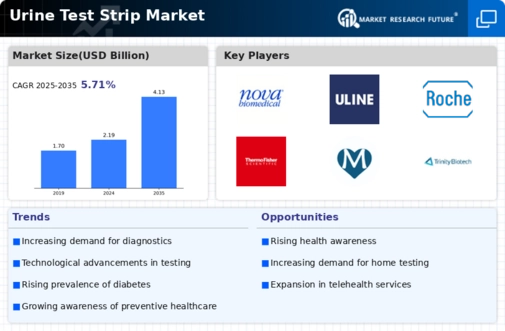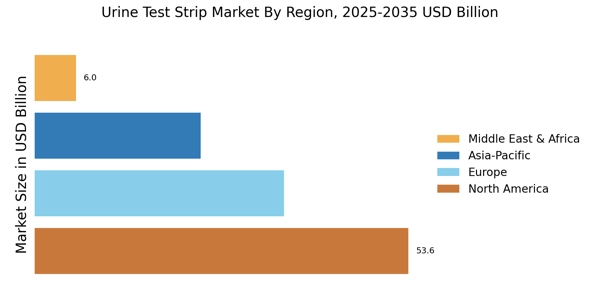Supportive Regulatory Frameworks
The Urine Test Strip Market is positively impacted by supportive regulatory frameworks that encourage the development and distribution of diagnostic tools. Regulatory bodies are increasingly recognizing the importance of accessible and reliable testing methods, leading to streamlined approval processes for urine test strips. This regulatory support not only fosters innovation but also enhances consumer confidence in the products available in the market. As regulations evolve to accommodate new technologies and methodologies, the market is likely to see an influx of novel urine test strip products, further driving growth and expanding consumer options.
Increasing Prevalence of Chronic Diseases
The Urine Test Strip Market is experiencing growth due to the rising prevalence of chronic diseases such as diabetes and kidney disorders. These conditions necessitate regular monitoring of patients' health, which urine test strips facilitate effectively. According to health statistics, the incidence of diabetes has been steadily increasing, leading to a heightened demand for diagnostic tools that allow for at-home monitoring. This trend is likely to continue, as more individuals seek convenient and cost-effective solutions for managing their health. The ability of urine test strips to provide quick results makes them an attractive option for both patients and healthcare providers, thereby driving the market forward.
Rising Awareness of Preventive Healthcare
The Urine Test Strip Market is also driven by the rising awareness of preventive healthcare. As individuals become more informed about the importance of early detection and regular health monitoring, the demand for urine test strips is likely to increase. Preventive healthcare emphasizes the need for regular check-ups and self-testing, which urine test strips facilitate effectively. This shift in consumer behavior is supported by various health campaigns and educational initiatives that promote proactive health management. Consequently, the market for urine test strips is poised for growth as more individuals recognize the value of monitoring their health proactively.
Growing Demand for Home Healthcare Solutions
The Urine Test Strip Market is significantly influenced by the growing demand for home healthcare solutions. As healthcare systems evolve, there is a noticeable shift towards at-home monitoring and self-diagnosis. This trend is particularly evident among aging populations who prefer to manage their health from the comfort of their homes. The convenience and ease of use associated with urine test strips align well with this demand, as they allow patients to conduct tests without the need for professional assistance. Market data indicates that the home healthcare segment is projected to expand, further propelling the adoption of urine test strips as essential tools for personal health management.
Technological Innovations in Diagnostic Tools
The Urine Test Strip Market is benefiting from ongoing technological innovations in diagnostic tools. Advances in strip technology, such as improved sensitivity and specificity, are enhancing the accuracy of urine tests. These innovations not only improve patient outcomes but also increase the reliability of results, which is crucial for effective disease management. Furthermore, the integration of digital technologies, such as mobile applications that track test results, is likely to attract a tech-savvy consumer base. As these advancements continue to emerge, they are expected to stimulate market growth by making urine test strips more appealing to both consumers and healthcare professionals.


















Leave a Comment